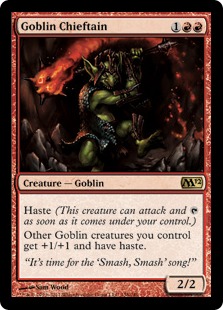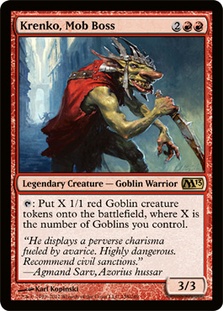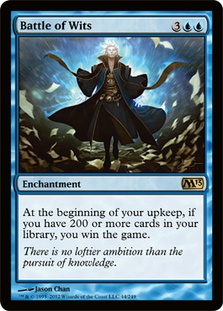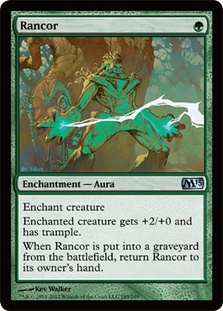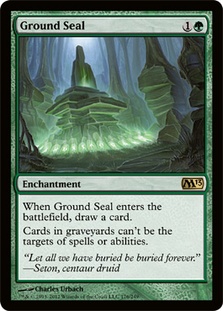We all love going ‘over the top,’ especially against an irritating deck like U/W Delver or Esper Midrange. Of course, as Standard players, one of the first things we do when a full set is spoiled is to search for that next ‘big’ archetype, since being able to play such a deck in a tournament before its known can present a significant advantage! There are a variety of ways to approach a new set, but the first and most tempting step is to look at the ubiquitous red deck.
There will be a small window of time, as we all know, when M12 and M13 both are legal sets, and in this small window, much like U/G Turboland prior to Time Warp’s rotation, there is an opportunity to take advantage of unique strategies. The first of these I’ll cover is Goblins.
Creatures (22)
- 4 Mogg Flunkies
- 4 Goblin Chieftain
- 4 Goblin Arsonist
- 4 Goblin Wardriver
- 2 Goblin Fireslinger
- 4 Krenko, Mob Boss
Lands (22)
Spells (16)

In addition to some spicy late game cards like Hellion Crucible, the most fundamentally powerful interaction in this deck is between Goblin Chieftain and Krenko, Mob Boss.
On the surface, it doesn’t appear as though Krenko is a playable card because he needs to survive for a turn before having an impact on the board and because he sometimes is just a Hill Giant. However, envision the following not-unrealistic sequence of plays:
Turn 1: Goblin Arsonist
Turn 2: Attack for 1, Krenko’s Command
Turn 3: Goblin Chieftain, attack for 8
Turn 4: Krenko, Mob Boss (tap for 5 tokens), attack for 18
Goblin Chieftain is the juice that Krenko, Mob Boss needs to be effective. There is a powerful, fundamental difference between creating tokens on the fourth turn and creating them on the fifth turn, and there is an even more significant difference when the tokens are 2/2 creatures rather than 1/1 creatures. However, even in less-than-ideal circumstances, the deck has the most powerful burn spell in the format in Goblin Grenade and is able to run eight copies of Incinerate. Searing Spear gets the nod over the new Arc Lightning because in a deck with 22 lands, three of which require ‘charging’ to become useful, that additional mana probably isn’t worth the added utility.
Haste is so powerful in this deck that we might even consider running an otherwise do-nothing (or combo-only) card like Fervor, but I’m not sure we should be going that deep yet. Initial tinkering with this shell suggests that it has the potential to be a contender during its short lifespan this summer.
The second summer Standard deck that piqued my interest is significantly less competitive, but it doubtless will appear at a few FNMs and perhaps even a PTQ or two for those brave enough to attempt it.
That’s right: I’m looking at Battle of Wits.
We have access to several cards pre-rotation that significantly strengthen our ability to play the deck, although the Tutors are not nearly as powerful as the transmute cards that fueled previous small format iterations of the deck. There is a not insignificant group of four Tutors that can immediately fetch a Battle of Wits, and it is here that our deck should begin.
4 Demonic Tutor
4 Rune-Scarred Demon
4 Increasing Ambition
4 Diabolic Revelation
4 Battle of Wits
Although we’ll undoubtedly play a variety of cantrips, draw spells, and control elements to survive the pivotal turns until we can win the game, we also need to consider the abstract cost of these cards (the cheapest at four mana). This suggests that we need some acceleration.
4 Alloy Myr
4 Sphere of the Suns
4 Manalith
4 Pristine Talisman
4 Palladium Myr
Putting it all together in a control-ish shell, we get a first pass at a potentially playable Battle of Wits deck:
Creatures (45)
- 4 Solemn Simulacrum
- 4 Vampire Nighthawk
- 1 Wurmcoil Engine
- 4 Palladium Myr
- 4 Consecrated Sphinx
- 4 Treasure Mage
- 4 Oculus
- 4 Alloy Myr
- 4 Phantasmal Image
- 4 Rune-Scarred Demon
- 4 Snapcaster Mage
- 4 Augur of Bolas
Planeswalkers (12)
Lands (102)
Spells (103)
- 4 Dissipate
- 4 Diabolic Tutor
- 4 Mana Leak
- 4 Mutilate
- 4 Barter in Blood
- 4 Battle of Wits
- 4 Think Twice
- 4 Ponder
- 4 Doom Blade
- 4 Elixir of Immortality
- 1 Contagion Engine
- 4 Sphere of the Suns
- 4 Black Sun's Zenith
- 1 Spine of Ish Sah
- 4 Go for the Throat
- 4 Pristine Talisman
- 4 Gitaxian Probe
- 4 Vapor Snag
- 4 Dismember
- 4 Manalith
- 4 Forbidden Alchemy
- 4 Thought Scour
- 4 Increasing Ambition
- 4 Amass the Components
- 4 Devastation Tide
- 4 Murder
- 4 Diabolic Revelation
- 1 Staff of Nin

It’s rather tough to break down the essence of a Battle of Wits deck because there are so many decisions that go into its construction. With the high volume of Tutors, for example, it may seem tempting to add a lot of singleton cards, but there rarely will be cases when the correct card for which to search is not Battle of Wits, so a redundant Tutor effect that can’t fetch the deck’s namesake is preferable when including singletons (i.e., Treasure Mage). The deck itself is fairly simple to play in some regards—mulliganing is one of the hardest decisions to make, followed by deciding how to shuffle the deck. If you’ve never played a Battle of Wits deck, even at a small tournament like FNM, I highly recommend trying it as it’s one of the more enjoyable ways to play Magic.
While we’re still in the realm of ‘big things,’ let’s take a look Mono-Green Aggro.
One reason that mono-green decks have declined in popularity, aside from the fact they don’t run Islands, is that they lose some of the reach provided by a red splash (i.e., Bonfire of the Damned) and can’t run one of the best four-drops in Standard: Huntmaster of the Fells. However, we might consider the reprinting of Rancor to be a unique call of nature after which we don’t even need to leave our chairs.
The obvious and most rewarding pairing is between Dungrove Elder and Rancor, though there are a number of other creatures that also beg for a chance to trample past some wimpy Spirits.
Creatures (23)
- 4 Llanowar Elves
- 1 Acidic Slime
- 2 Arbor Elf
- 1 Bellowing Tanglewurm
- 1 Thrun, the Last Troll
- 4 Dungrove Elder
- 4 Strangleroot Geist
- 2 Wolfir Silverheart
- 1 Mwonvuli Beast Tracker
- 3 Thragtusk
Lands (23)
- 23 Forest
Spells (13)

In addition to Rancor’s added power and versatility, mono-green gains Thragtusk which, while easily Mana Leaked (if they haven’t tapped out to deal with our other threats), is extremely problematic for Delver if it hits the table. Even their most “elegant” solution, Vapor Snag, leaves us with four life and a 3/3 Beast token. The additional power from Wolfir Silverheart also looks significantly better when it more easily can push past 1/1 tokens in the red zone.
Green also gains excellent anti-Snapcaster and anti-Solar Flare tech in Ground Seal with the release of M13; unlike many other limited scope answers found in green, Ground Seal immediately replaces itself. Silklash Spider is likewise a viable sideboard card since it blocks nearly every relevant creature in Standard and easily can clear the air at instant speed.
Finally, with two potentially competitive aggro decks out of the way, let’s return to a place closer to Battle of Wits to close out the article.
While it is unclear whether Omniscience is better than Dream Halls in Legacy because Dream Halls actually can be casted (though its effect is less powerful in the abstract), little mind has been paid to it in Standard…being a ten-mana enchantment and all.
As long as Primeval Titan exists in Standard, though, there is always a chance. If we want to try to win with Omniscience, we need to be fairly certain that the game will end as soon as it hits the table. To do this, we need to borrow a page from Delver’s playbook and fill our deck with cantrips. An initial shell for the deck might look like this:
Creatures (10)
Lands (24)
Spells (26)

While this deck falls closer to the casual FNM side than to the competitive side, it is designed so that a resolved Omniscience frequently enables a chain of spells that will win the game with little interaction from our opponents. This build is less resilient to aggressive decks than traditional ramp builds (i.e., no removal), but in the absence of disruption it actually has a reasonable clock.
Whichever direction we choose to go after M13’s release, competitive or casual, it is clear that Wizards has done a good job of shaking up the format even before the fall rotation.

